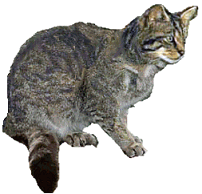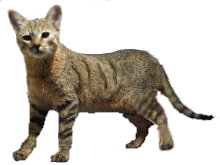Original cats
If you are letting someone into your life, its a good idea to know about their family, and this is true of cats as well as people. That little bundle of fur purring at your feet is actually a highly-evolved predator, and while he is happy to leave you to operate the tin-opener, the rest of the family are out there terrorizing everything from small mammals to third-world peasant farmers. |
Meet the Felidae
The Felidae family includes all the animals we generally refer to as cats, from lions and tigers to domestic moggies. Overall, there are six main branches, (genera) and 38 main types (species). Probably to the disgust of taxonomists we will define large cats - lions tigers etc - as genus Panthera, and small cats as genus Felis. To clear things up further, if it can roar, it is genus Panthera, if it can purr, its genus Felis. None of the Felidae can do both.
Grandpa
The oldest cats were about in the Oligocene era, which was about 30 million years ago (but you knew that). By the standards of some of his descendants, Proailurus was a lightweight of about 20 pounds. His descendants grew considerably larger, and 10,000 years ago most cavemen who met Smilodon fatalis (the sabre-toothed tiger) probably had domestication very far from their minds. Cats, like humans, spread across the world, and big and small cats are native to all the continents except Australia and Antartica.
Immediate family

Felis Lybica
It is probable that the most immediate ancestor of the domestic cat is Felis Lybica, which is generally called the African wild cat, although it has done a pretty good job of colonizing most of the Middle East. Lybica's neighbours are the Ornata family (Indian wild cats) which are found in the steppes and semi-deserts of the Middle East, India, Russia, and China. Though different sub-species of Lybica vary in size, they generally have sandy or ginger fur, with stripes, or stripes broken into spots. Those living in near-desert conditions tend to have lighter-coloured fur. Kittens are generally born around June, and there are two to four kittens per litter. These cats mature fast, and start hunting their own food within three months. They are fully independent after five months, and mature within twelve.
European wildcats want nothing to do with humanity, and even their kittens are generally untameable. However, Lybica cats are quite amenable to domestication if raised from kittens,and even wild Lybicae can be found hanging around human settlements.

Felis Silvestris
The European wildcat is an old species - bones half a million years old have been discovered. The modern Silvestris generally found in the woodlands of Europe (though not Ireland or northern Scandinavia), and it is these woodlands that give the cat its name: silva is 'woodland' in Latin. Considerably larger than a domestic cat, Sylvestris is about half a metre long. There is about another 30cm of tail behind; thicker than Lybica's tapering version, and with a blunter tip. Sylvestris weighs in at 4-5 kilograms. The fur is grey or brown, and both longer and thicker than Lybica's. Silvestris is an accomplished hunter, and will happily kill and eat small deer, squirrels, and small dogs, or (in a total absence of family feeling) domestic cats; though it is also quite happy to mate with the latter depending on which appetite is dominant at the time.
The last recorded wild cat in England was shot about 150 years ago. British wildcats are now firmly protected by law, though this gives them less protection than it should, because after 1000 years of interbreeding with domestic cats, it is hard to distinguish clearly between Felis Silvestris (the wild cat) and Felis Silvestris Catus (the feral domestic cat; 'feral' being the technical term for domestic cats which have gone wild).
Felis Catus
The domestic cat appeared on the scene relatively recently; about seven thousand years ago. Not co-incidentally, Felis Catus appeared in the Middle East about the time when humans in the area decided to give up nomadic hunting and settle down to an agricultural existence which happened to include mouse-infested grain bins. Cats were fully domesticated in Egypt by 4000 BC, though the original domestic cat differed from modern cats in that they were probably Lybicae, while most modern domestic cats are descended from European breeds which picked up a good streak of Sylvestris while taking a walk on the wild side.

